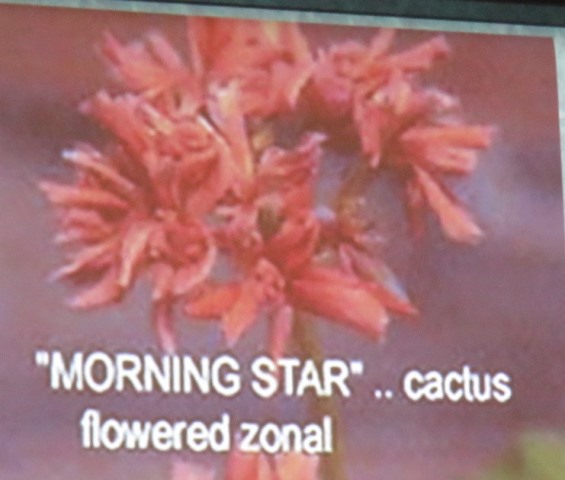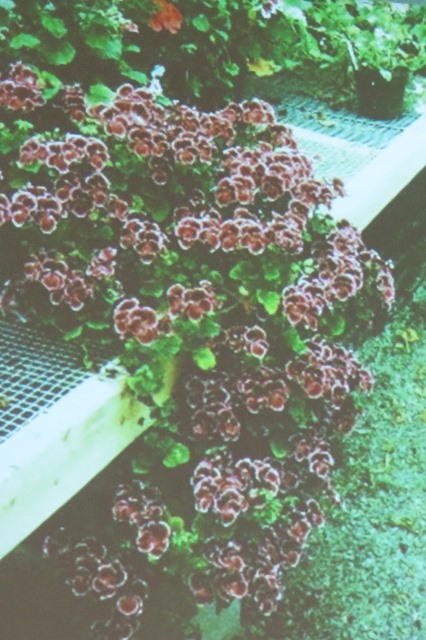The Geraniaceae Family by Marilyn Holt
Marilyn Holt from Buckerfields certainly knows her Geraniaceae family! She showed us more of these flowers than most of us even knew existed! By the way, almost all plants sold as geraniums in Garden shops are actually pelargoniums! Geraniums are native to temperate climates, have smaller flowers, sprawling growth, and are often used as groundcovers. Pelargoniums are native to warm temperate and tropical climates. They have showy flowers and are frequently used in containers and as bedding plants. They originate from Africa, Turkey, Iraq, and Iran, but also from Madagascar, Australia, New Zealand, and Tasmania.


There are many varieties of pelargoniums/geraniums. Often the 2 top petals are different from the 3 bottom ones. Zonal geraniums, with a distinctive marking on the leaves, are the most commonly sold. Ivy-leaved geraniums are used as trailing plants in baskets. Regal Geraniums have large, rose-like blooms but don’t like hot mid-day sun. Scented-leaved geraniums emit a fragrance when touched. Angel Geraniums have smaller leaves and flowers but are very popular.
The Geraniaceae family consists of: Erodium, Geranium, Monsonia, Sarcocaulon, and Pelargonium.
The Erodium genus of plants is also known as Stork’s Bill or Heron’s Bill. There are about 80 species. They bloom best in full sun but will also grow in partial shade.

The (true) Geraniums have about 430 species and are sometimes referred to as ‘hardy geraniums’ or ‘cranesbill’. Some of Marilyn’s choices were: G. versicolour ‘Glendale Monarch’, G. clarkei ‘Kashmir Purple’ (vigorous ground cover), G. nodosum (long-lasting in dry shade), G. ‘Orion’ (large lavender-blue flowers), Geranium ‘Rozanne’ (flowers well in partial shade).


The Monsonia (about 40 species) are very different in appearance, having thorny branches. Marilyn showed us Monsonia emarginata, M. crassicaule, M. pattersonii.


The Sarcocaulon (about 14 species) are unique in their appearance as well. They are succulents and are often displayed as bonsai plants. We were surprised when we saw Sarcocaulon paniculatum and S. multifidum.


The Pelargonium family was certainly more familiar! There are more than 280 species. In this family are Angels (upright and trailing), Formosums, Frutetorums, Ivy Leafs, Balcon Ivy Leafs, Ivy x Zonal, Regals, Scented Leaf, Species & Species Hybrids, and Uniques.
Zonals have the characteristic of ‘zone’ markings on their leaves. The term “butterfly” for the Fancy Butterfly Leaf refers to the shape of the inside marking on the leaves. Stellar’s are known to bloom first and in low light. ‘Vancouver Centennial’ is particularly popular here!






Some species mentioned were: ‘Ann Richards’, ‘Bobberstone’, ‘Distinction’; Dwarf / miniature zonals were ‘Zena’, ‘Powderpuff’; Fancy leaf zonals: ‘Butterfly Leaf’, ‘Freak of Nature’; Gold Leaf Zonals: ‘Mosaic Silky’, ‘Mrs. Quilter’; Silver Leaf Zonals; Tri-Colour Zonals: ‘Pink Dolly Vardon’, ‘Encore’, ‘Wirral New Look’; Fancy Dwarf and Miniature Zonals: ‘Annsbrook Hope’, ‘Bio Lilac Mist’, ‘Golden Chalice’, ‘Qwen’ (a micro-miniature grown in a 2 ½ inch pot!), ‘Kleiner Liebling’, ‘Pink Bird’s Egg’; Unusual Flowered Cactus: ‘Attraction’, ‘Mini Czech’, ‘Morning Star’; Unusual Flowered Carnation: ‘Diana Palmer’, ‘Jeanne’, ‘Lancastrian’; Unusual Flowered Rosebud: ‘Appleblossom’ Rosebud, ‘Australian Pink’ Rosebud, ‘Plum Rambler’, ‘Rosette’, ‘Westdale Appleblossom’; Unusual Flowered Tulip; Stellars: ‘Vancouver Centennial’, ‘Elsie Gillam’, ‘Fairy Phlox’.


Formosum are also known as ‘fingered leaf’. Marilyn showed us ‘Deerwood Wildfire’, ‘Golden Formosum’, ‘Urchin’.
We saw Frutetorum Hybrids ‘Meadowside Jamboree’; Ivy Leaf: ‘Arctic Frost’, ‘Beauty of Diane’, ‘Mauve Beauty’, ‘White Mesh’; Balcon Ivy Leaf: ‘Mini Red Cascade’; Ivy x Zonal (zonal sized blooms on a trailing plant).


Marilyn explained that Angels look like mini Regals and look great in baskets. Some examples shown were: ‘Black Knight’, ‘Charmay Alf’, ‘Debbie’, ‘Australian Mystery’,


Some Regal Pelargoniums: ‘Blue Moon’, ‘Botany Bay’, ‘Rimfire’. A Regal can also be grown as a standard!


Uniques are a cross between Regals and Species pelargoniums. Scented Leaf examples are: ‘Sweet Memory’, ‘Hansen’s Wild Spice’, ‘Islington Peppermint’.
Some examples of Species are: Pelargonium ‘appendiculatum’, P. ‘caffrum’. Enthusiasts are always working on new varieties, and Cliff Blackman, an Australian hybridizer, notably managed to develop a pelargonium with yellow!

Marilyn informed us that pelargoniums and geraniums are easy to propagate. Be sure to take cuttings with a clean razor blade, not scissors. Slice just below a node. If you have a warm location or bottom heat, they don’t need hormones. Speckles or stripes are actually from a virus so if you use rooting hormone then the cuttings don’t root properly! Pelargoniums should not be kept too moist. They need to dry out between watering and must not stand in water. If you use peat pucks you need to peel off the fiber mesh before potting up. When peat dries it turns into a clump in which the roots can’t survive. Container mix sometimes has too much peat and/or too much perlite. Marilyn likes the brand “My Soil”, which comes from Vancouver Island.

Marilyn gave us some other tips as well. She warned us against using bark mulch in the garden, as it leaches the nitrogen out. Flowering plants use phosphorus the most, so choose a fertilizer with a high middle number such as 10-30-10. Epson salts (natural, not the scented bath variety!) can help with developing sturdy leaves, bigger flowers, and brighter colors. Marilyn mixes 1 1/2 tablespoons into a liter of water. She applies it once a month along with her fertilizer. If you plan to overwinter your hanging baskets, wooden containers protect better than plastic.
Marilyn invited us all to visit the expansive Buckerfields’ store, which is just off the Clearbrook Rd. exit in Abbotsford. After seeing all her wonderful slides, we are sure it would be well worth the drive. No doubt our trunks (and back seats!) would be packed full of beautiful plants before we headed home! Thank you so much, Marilyn, for your colourful presentation!


RELATED LINKS
Buckerfields – Marilyn’s home base!
https://www.buckerfields.ca/garden-centre
Botanico Hub: The Geraniaceae Family
https://www.botanicohub.com/plant-families/geraniaceae
Plant Systematics: 172 images of the Geraniaceae family
http://www.plantsystematics.org/cgi-bin/dol/dol_terminal.pl?family=Geraniaceae
Check out our own set of links on Geraniums and Pelargoniums!
Links: Fuchsias, Begonias, Pelargoniums/Geraniums – BC Fuchsia and Begonia Society (bcfuchsiasociety.com)
 Previous Post
Previous Post Next Post
Next Post
Recent Comments